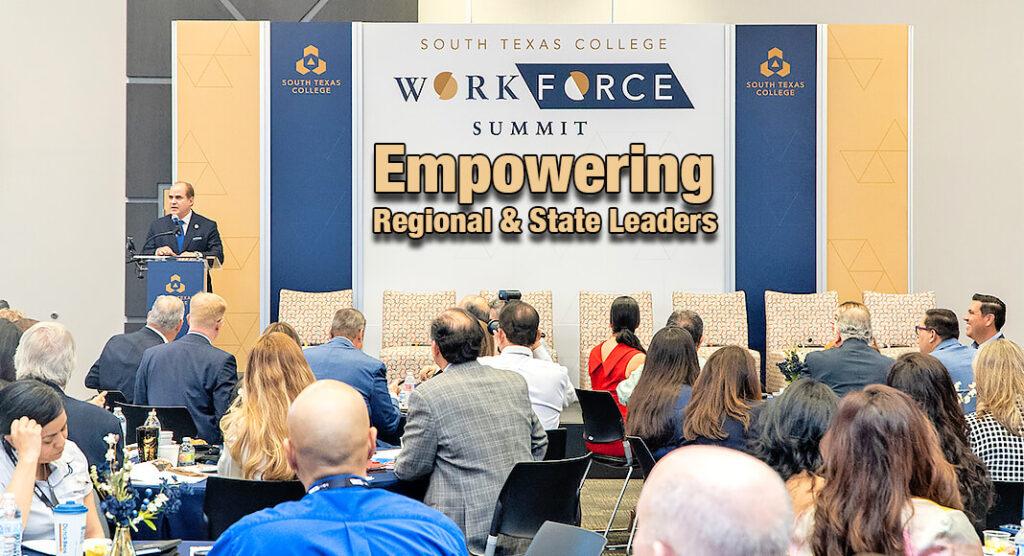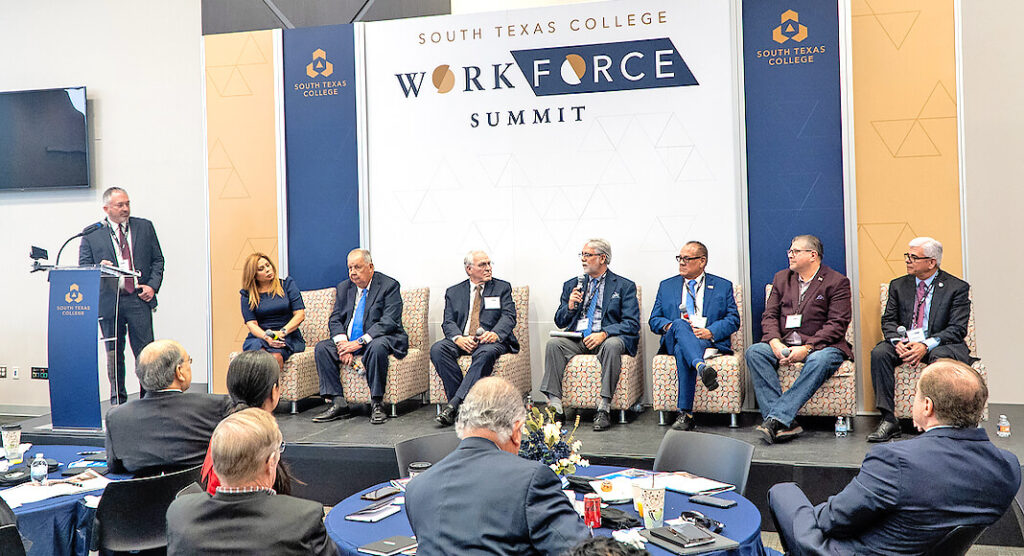
Texas Border Business
By Amanda Sotelo
From emerging technologies to House Bill 8, the third annual Workforce Summit hosted by South Texas College covered major topics affecting institutions of higher education and workforce training programs across Texas.
“Our Workforce Summit grows every year, and the increase in attendance is a testament to the impact this summit has on our industry partners regionally and statewide,” said STC President Ricardo J. Solis. STC is at the forefront of apprenticeships, innovative technology, and meeting industry demands. In turn, we are changing lives, transforming generations, and helping to build robust economies.”

The all-day event featured panelists from the Texas Workforce Commission (TWC), Hidalgo County Judge Richard Cortez, representatives of local economic development corporations, Starr County Industrial Foundation President and STC Board Chair Rose Benavidez, STC faculty, and representatives from the college’s Center of Advanced Training and Apprenticeships.
Each discussion, moderated by Executive Vice President and Director of Community Relations for Lone Star National Bank Julian Alvarez, focused on industry-recognized credentials and what they mean for employability, living wages for the residents of Hidalgo and Starr Counties, how higher education is driving the economy in the Rio Grande Valley, and how STC is leveraging emerging technologies into student learning.
Albert Trevino, TWC commissioner representing labor, said the state is making great progress and everything is changing so much faster than anticipated, so partnerships, like the one with STC, are vital in creating success throughout the state.
“Now is the time to accelerate the type of education provided to keep our state and its residents moving forward,” said Trevino. “I’m so glad to be back at STC; I appreciate the leadership and all they do for our students beginning as early as high school with their dual credit programs and training. There is still so much left to do in educating people across the state to continue closing the skills gap, but partnerships like those at the Workforce Summit are vital in sharing resources and best practices and strengthening our state.”
In addition, Harrison Keller, Ph.D., commissioner of higher education from the Texas Higher Education Coordinating Board, served as the keynote speaker. He highlighted how recent legislation, such as House Bill 8, which created an outcome-based funding model for community colleges in Texas, is impacting institutions of higher education like STC.
“In Texas, we are making great progress, but our needs and our economy are evolving quickly, and leadership at STC, as a long-standing partner, is remaining at the forefront of ensuring that they remain proactive in meeting the needs of industry and our economy, their programs are aligned with the state’s changing needs. We are creating the kind of Texas we want to live in with the opportunities we are providing.”
The topics and dialogue shared at the workforce summit continue to move our region forward, said Anahid Petrosian, Ph.D., STC vice president and provost for Academic Affairs.
“Our programs have some of the most advanced training labs and simulators in the Rio Grande Valley,” she said. “We are unique in that we have always worked toward an outcome-based model because our goal has always been to get students trained and into the workforce. This year’s workforce summit has seen record attendance, and it’s because these discussions are changing the landscape of our area and our state, and through partnerships, we all succeed.”
About emerging technologies, for the first time, STC had demonstrations and hands-on opportunities to use training tools and equipment such as the college’s newest artificial intelligence dog, geospatial and surveying sandbox, nursing simulation video technology mannequins and automotive engine simulator.
Cortez, who also leads the Hidalgo County Prosperity Task Force, added that there is a collaborative effort to end poverty in the RGV.
“With topics such as living wages being covered, we’re able to continue the conversation about ending poverty in our region,” said Cortez. “A major key to ending this (poverty) is education and collaboration between many of our community’s partners. Wages contribute a lot to our economy. The Rio Grande Valley is growing, and we are improving the diversity of job opportunities available in our area. The training to get these jobs is available right here. We are seeing success in many parts of our county.”
Benavidez said it is great to see so many leaders and professionals in one room working together to empower RGV residents and enhance and improve the opportunities available in the region.
“This Workforce Summit every year, serves as an opportunity to remind everyone that the work that we’re doing is only as valuable as the effort we put into collaborating data and efforts to help a greater population and respond to the needs and the challenges that many in our region face,” said Benavidez. “The gap there was before in educational attainment is narrowing, and it is in great part because of the creation of South Texas College…it’s a catalyst for economic development, moving us out of poverty and into prosperity.”
For more information on STC’s Workforce Training programs and more than 120 certificates and degrees offered, visit https://www.southtexascollege.edu/














